Egyptian - Sold antiquities
Archive of sold antiquities
All artefacts sold in our gallery are fully documented in our online archive and database. Being a specialist ancient art dealer, preserving also the more recent history of each and every piece sold in our shop is at our heart. That is particularly useful for artefacts that changed owners in the meantime. Information that may have been lost in the process can be easily restored from our archives. Please do not hesitate to contact us if you need further information about ancient items that have been sold in our gallery. We can help you with reconstructing the history of ownership for those items. All information about our customers will be kept confidential, of course.-
 Bronze statuette of Osiris
Bronze statuette of OsirisThe figurine is in exceptional condition with a nice patina. Late Dynastic period of Ancient Egypt, 664 to 332 BC.
Price: on request Pre-Dynastic pottery of Ancient Egypt
Pre-Dynastic pottery of Ancient EgyptThe simple vessel is made of coarse clay. It dates to the end of the 4th millenium BC and hence witnessed the beginning of the Ancient Egyptian civilization.
Price: on request Egyptian frog lamp from very old German collection
Egyptian frog lamp from very old German collectionThe frog lamps developed in Egypt close to Abydos. For the Egyptians, the frog symbolized birth and resurrection, this symbolism was also adapted by the early Christians. From the German collection Becker, in this for 3 generations.
Price: on request Cowroid with decorated body
Cowroid with decorated bodyThe cowroid has an interesting decoration across the upper surface. The lower surface is inscribed with hieroglyphs. This cowroid is discussed in the catalogue of Gautier-Vodoz.
Price: on request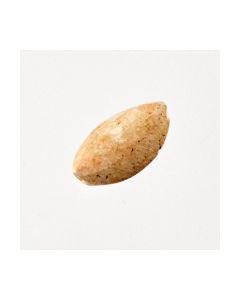 Cowroid with magic spell
Cowroid with magic spellThe hieroglyphs of the anra type are to be interpreted as magical formula. From the Second Intermediate Period of ancient Egpyt. This scaraboid is described in the catalogue of Gautier-Vodoz.
Price: on request Cowroid with Ankh and papyrus
Cowroid with Ankh and papyrusThe seal is engraved with the breath of life between two papyrus plants. This scaraboid is described in the catalogue of Irène Gautier-Vodoz.
Price: on request Scaraboid from the Middle Kingdom
Scaraboid from the Middle KingdomThe stamp shows hieroglyphs with a title for the king of Upper and Lower Egypt. This scaraboid is described in the catalogue of Irène Gautier-Vodoz.
Price: on request Scarab with lion
Scarab with lionThe scene shows a walking lion. It is framed by an oval cord. This scarab is described in the catalogue of Irène Gautier-Vodoz.
Price: on request Scarab with protective formula
Scarab with protective formulaAmulet for protection. Stilized lotus flowers on the upper side. Magic formula on the lower side. This scarab is described in the catalogue of Irène Gautier-Vodoz.
Price: on request Scarab with geometric motive
Scarab with geometric motiveThe lower side exhibits a symmetrical arrangements of cords, two of which are wrapped around each other. This scarab is described in the catalogue of Irène Gautier-Vodoz.
Price: on request Scarab with geometric motive
Scarab with geometric motiveThe motive exhibits two symmetry axes and at least six triangles. A wonderful artistic expression of the highly evolved Egyptian maths. This scarab is described in the catalogue of Irène Gautier-Vodoz.
Price: on request Scarab with pattern of circles
Scarab with pattern of circlesThe beetle stone bears a popular motive of the Middle Empire. A nice example of its kind. This scarab is described in the catalogue of Irène Gautier-Vodoz.
Price: on request Scarab with magic spell
Scarab with magic spellThe hieroglyphs are of the so called anra design, a magic spell in the ancient Egyptian belief. The scarab is from the 13th to 15th dynasty. It is described in the catalogue of Gautier-Vodoz.
Price: on request Egyptian shabti
Egyptian shabtiFunerary statuette of faience. The opposed hands might indicate Tanis as origin. Third Intermediate Period of Ancient Egypt.
Price: on request Egyptian ushabti from the Third Intermediate Period
Egyptian ushabti from the Third Intermediate PeriodFunerary statuette of faience with black paint. The opposed hands might indicate Tanis as origin. Third Intermediate Period of Ancient Egypt.
Price: on request Scarab with hieroglyphic formula
Scarab with hieroglyphic formulaThe piece is from the Second Intermediate Period. It was probably meant as a good fortune or protective amulet.
Price: on request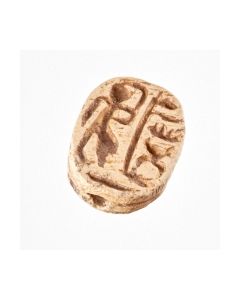 Scarab with cartouche
Scarab with cartoucheThe scarab from the late Ramesside period shows a standing person. A cartouche in front bears the name of pharao Mencheperre, who was famous as Thutmose III.
Price: on request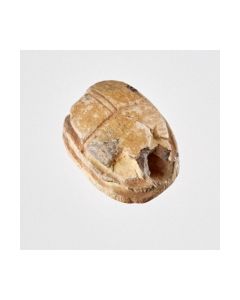 Egyptian Scarab with hieroglyphs
Egyptian Scarab with hieroglyphsInteresting scarab made of steatit with inscription for Amun. Dating to the 19th to 21st dynasty of ancient Egypt.
Price: on request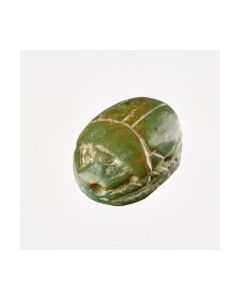 Scarab with Amun inscription
Scarab with Amun inscriptionBearing the hieroglyphs "the god Amun of Theben is lord". From the Late Period of ancient Egypt. Beautiful green stone.
Price: on request Scarab with pharao on throne
Scarab with pharao on throneThe piece dates to the Third Intermediate Period and was probably produced in Tanis. It shows a pharao with a subordinate.
Price: on request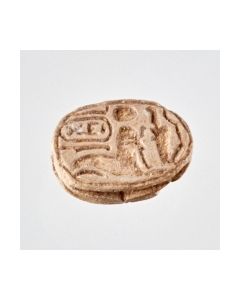 Memorial scarab for Thutmose III
Memorial scarab for Thutmose IIIA royal sphinx and Maat, the goddess of truth and justice adorn the lower side. Above them is the cartouche of Mencheperre. The piece is probably from the regin of Ramesses IV or V.
Price: on request Egyptian Scarab with sun beetle
Egyptian Scarab with sun beetleThe scarab amulet from Ramesside times has a beetle engraved in the lower side, flanked by two symbols.
Price: on request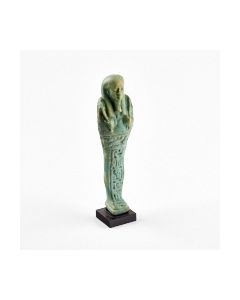 Egyptian funerary figurine of General Semataui
Egyptian funerary figurine of General SematauiVery well preserved ushebti from the Late Period of ancient Egypt. An expertise from 2015 comes with this object. From an old British collection.
Price: on request Scarab with wishes
Scarab with wishesNice scarab made of dark steatite. The hieroglyphs could be read as New Year's wishes.
Price: on request Scarab with twisted cord
Scarab with twisted cordScarab amulet with a twisted cord motive. Beautiful and well preserved piece from the Second Intermediate Period.
Price: on request Scarab with cartouche
Scarab with cartoucheThe scarab amulet has a cartouche and neb on the bottom. 18th to 20th dynasty of ancient Egypt.
Price: on request Egyptian Scarab
Egyptian ScarabThe scarab amulet is made of steatite. It has a hieroglyphic inscription on the lower side, including a reference to Amun-Re.
Price: on request Egyptian Scarab
Egyptian ScarabThe scarab amulet is made of steatite. It has a hieroglyphic inscription on the lower side.
Price: on request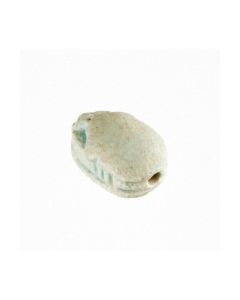 Scarab with wishes
Scarab with wishesNice mint green scarab. The hieroglyphs could be read as New Year's wishes.
Price: on request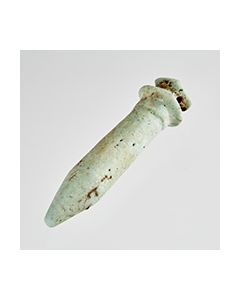 Egyptian papyrus scepter amulet
Egyptian papyrus scepter amuletPapyrus scepter made of faience. Late Period of Ancient Egypt. It symbolizes prosperity and youth. From the stock of a british private museum.
Price: on request Egyptian papyrus scepter amulet
Egyptian papyrus scepter amuletPapyrus scepter made of faience. Late Period of Ancient Egypt. It symbolizes prosperity and youth. From the stock of a british private museum.
Price: on request Central part of a mummy cartonnage
Central part of a mummy cartonnagePolychrome painted panel depicting the four sons of Horus and a representation of Kheper-Ra. The collar is resembling the falcon wing of Horus.
Price: on request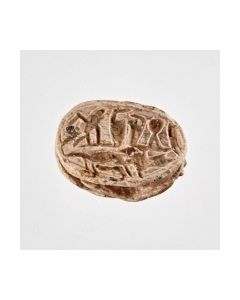 Scarab from the Ramesside period
Scarab from the Ramesside periodThe bottom side shows Horus, Uraeus and crocodile. The crocodile could be interpreted a the god Sobek.
Price: on request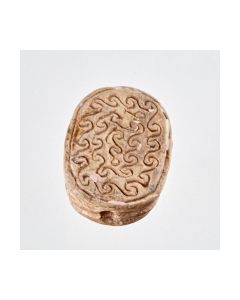 Scarab with spiral design and symbol for good luck
Scarab with spiral design and symbol for good luckThe Egyptian scarab from the Second Intermediate Period is decorated with a geometrical pattern. A nefer hieroglyph stands for good luck.
Price: on request Scarab with geometric design
Scarab with geometric designLovely scarab with traces of turquoise fayence. From the Second Intermediate Period of ancient Egypt.
Price: on request Hellenistic marble portrait of a youth
Hellenistic marble portrait of a youthPossibly Ptolemaios III or IV or a private portrait following the official style.
Price: on request

